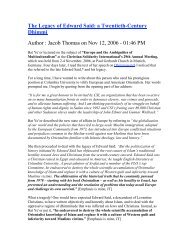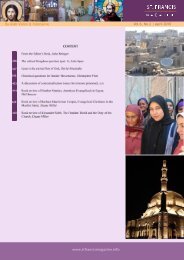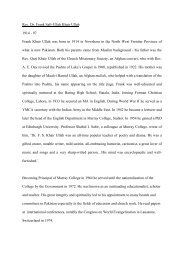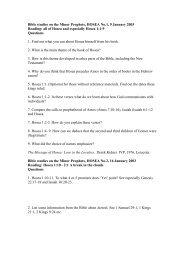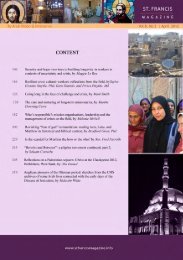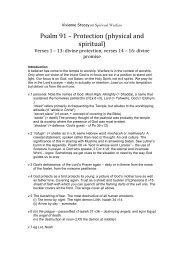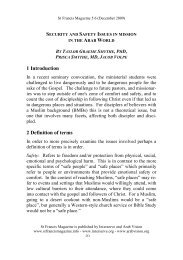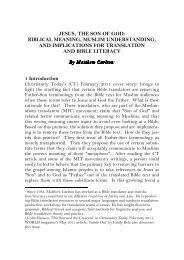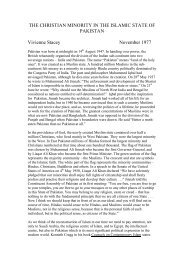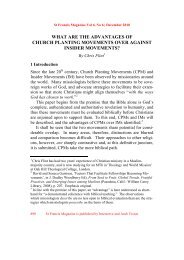download the pdf - St.Francis Magazine
download the pdf - St.Francis Magazine
download the pdf - St.Francis Magazine
Create successful ePaper yourself
Turn your PDF publications into a flip-book with our unique Google optimized e-Paper software.
<strong>St</strong> <strong>Francis</strong> <strong>Magazine</strong> Vol 8, No 4 | August 2012<br />
Leaders with <strong>the</strong> Iranian community are held in high regard.<br />
Iranians are known to ascribe devotion to people in authority.<br />
Ebadi describes to what extent Iranians have a cult of leaders.<br />
Unfortunately, Iranians are at heart hero worshippers….<strong>the</strong>y cling to<br />
<strong>the</strong> notion that one lofty, iconic figure can sweep through <strong>the</strong>ir lives,<br />
slay <strong>the</strong>ir enemies, and turn <strong>the</strong>ir world around. Perhaps o<strong>the</strong>r cultures<br />
also believe in heroes, but Iranians do so with a unique devotion. Not<br />
only do <strong>the</strong>y fall in love with heroes, but <strong>the</strong>y are in love with <strong>the</strong>ir love<br />
for <strong>the</strong>m (Ebadi 2007, 147).<br />
Patron-client relationships and power structures of fellowships<br />
are ano<strong>the</strong>r dimension. The Islamic view of power is often viewed<br />
as guardian leader (Beekun and Badawi 1999, 2). King recognizes<br />
that most of <strong>the</strong> literature on patron-client social structures emanates<br />
from within <strong>the</strong> Middle East. “Iran is clientelistic and is composed<br />
of many autonomous parallel groups formed in patron-client<br />
bounds”. (Alamdari 2005, 1298) Clerics function as glorified social<br />
welfare agents who ga<strong>the</strong>r money and dispense it. This gives <strong>the</strong><br />
cleric independent power (Mackey 1996, 118).<br />
Despite <strong>the</strong> hierarchical nature of Iran it is difficult to determine<br />
where a leader leads and <strong>the</strong> follower follows.<br />
Lay men look to <strong>the</strong>ir leader for guidance and pattern <strong>the</strong>ir behavior<br />
accordingly. At <strong>the</strong> same time, <strong>the</strong> cleric from his position of authority<br />
seeks to understand <strong>the</strong> will of his followers and <strong>the</strong>n to shape his policies<br />
to reflect that will. As a result, religious leadership, unlike kingship,<br />
is circular ra<strong>the</strong>r than vertical. The leader both leads and follows<br />
and <strong>the</strong> followers both follow and lead (ibid, 118).<br />
Even in <strong>the</strong> diaspora, new patron-client relationships are sought<br />
to replace <strong>the</strong> old ones. “Hope is a key component of patronage and<br />
clientage.” (King 2005, 321) Patron-client relationships influence<br />
normative ideas about migration and resettlement processes (ibid,<br />
324). It is possible that this repositioning influences relationships in<br />
<strong>the</strong> church.<br />
Church structure is also an area of concern. Tracing how <strong>the</strong><br />
new community shapes its structures of power to its own ideas and<br />
interest is important to understand (Geller 2008, 2). Geller sug-<br />
<strong>St</strong> <strong>Francis</strong> <strong>Magazine</strong> is a publication of Interserve and Arab Vision 426




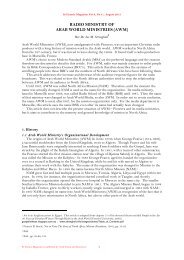
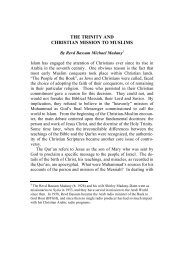
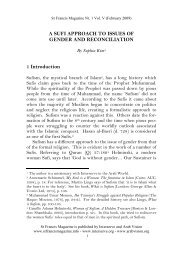
![Reflections on Surah Fatiha and the Lord's Prayer[1] - St.Francis ...](https://img.yumpu.com/49377951/1/184x260/reflections-on-surah-fatiha-and-the-lords-prayer1-stfrancis-.jpg?quality=85)
